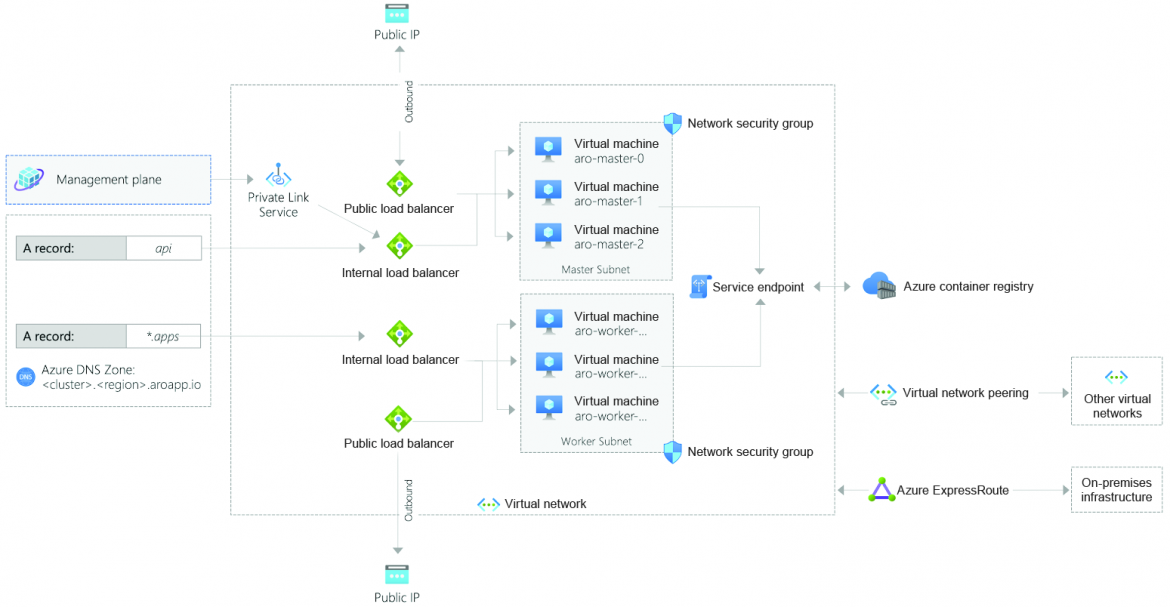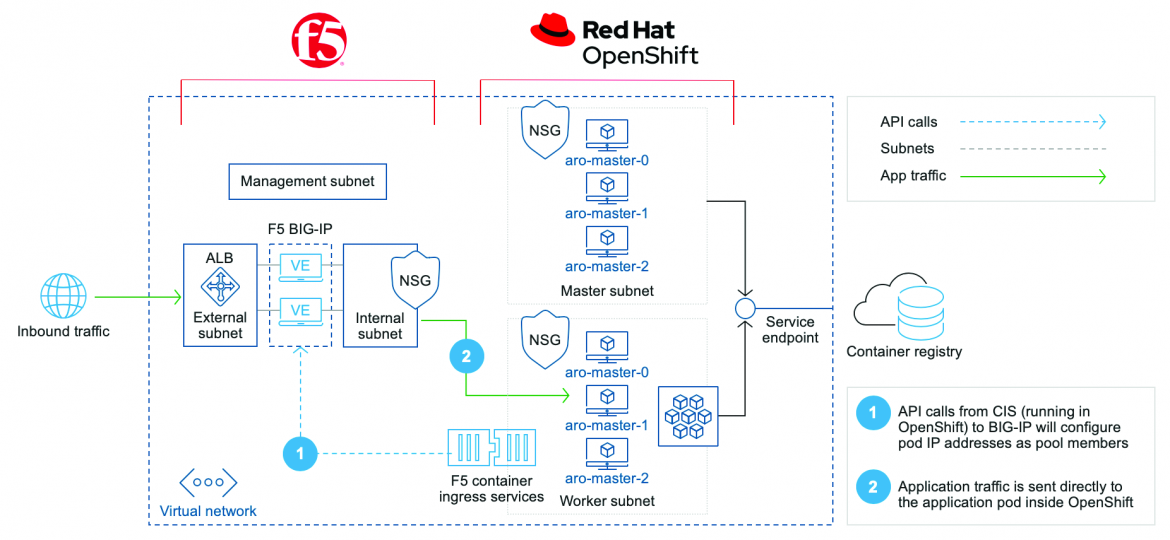Provision BIG-IP on Microsoft Azure Red Hat OpenShift
Microsoft Azure Red Hat OpenShift for BIG-IP VE
BIG-IP virtual editions (VE) for Azure integrated with Azure Red Hat® OpenShift® lets you take advantage of the elasticity of the public cloud while continuing to manage and better secure critical applications as you would when they’re hosted on-premise. Whether you want to move your applications entirely to Azure cloud, use a hybrid private-public cloud network, or deploy a multicloud architecture, BIG-IP VEs for Microsoft Azure can help increase efficiency, optimize performance, and bolster security.
How Red Hat OpenShift and Azure work together
While Red Hat OpenShift can be deployed and operated on-premise or in cloud technology (public or private), many enterprises find that a managed offering on Azure is the best way to use Red Hat OpenShift. Azure Red Hat OpenShift is jointly engineered, operated, and supported by Microsoft and Red Hat. It provides guaranteed uptime and availability with a defined service-level agreement (SLA), better security, and compliance. You can scale on your terms, from 10 containers to thousands, and only pay for what you need through a consumption-based, pay-as-you-go model.
Azure Red Hat OpenShift can be deployed as a fully managed service, eliminating the complexity of implementing and managing the platform. F5 and Red Hat accelerate the transformation to Red Hat OpenShift in cloud computing by improving provisioning and operating processes and securing Red Hat OpenShift clusters.
Azure Red Hat OpenShift comes with a well-documented process for deploying clusters. Using documented instructions, network managers can create a standard Red Hat OpenShift deployment like the one shown below in about 35 minutes.
Key Benefits
- Accelerate application transformation, easily migrate existing applications to containers, and run within Azure Red Hat OpenShift
- Manage, automate, and better secure container environments
- Jointly developed, co-engineered solution. Microsoft SKU + F5 Big IP in Marketplace
- Smooth integration with F5 BIG-IP
- Optimize a fully managed container service from three trusted companies
- Day 2 operations management
- Business continuity and multicluster management

BIG-IP on Azure Red Hat OpenShift
F5 and Microsoft deliver a joint solution for adopting zero trust cybersecurity across all of an organization’s applications—including on-premise classic applications as well as enterprise applications deployed to Azure Red Hat OpenShift. F5 BIG-IP provides these services using container ingress services (CIS) to help scale applications and services across clusters and sites. In addition, F5 BIG-IP offers advanced access and security control for traffic going into or out of a Red Hat OpenShift cluster for consistent policy enforcement and end-to-end compliance in any cloud.
F5 also provides administrators the necessary tools to greatly ease configuration and management of the Azure Red Hat OpenShift deployment. Instead of using the previously mentioned guidance provided by Microsoft, F5 users can take advantage of an easy-to-use template to provision an Azure Red Hat OpenShift cluster while simultaneously configuring BIG-IP to provide advanced application delivery and security capabilities. This entire process can be accomplished in about 35 minutes and leaves the user with a deployment similar to the one shown here.
About F5:
F5 (NASDAQ: FFIV) is a multicloud application security and delivery company that enables our customers—which include the world’s largest enterprises, financial institutions, service providers, and governments—to bring extraordinary digital experiences to life. For more information, go to f5.com. You can also follow @F5 on Twitter or visit us on LinkedIn and Facebook for more information about F5, its partners, and technologies.

Deployment can be accomplished in six simple steps using a template and step-by-step guidance provided by F5:
- Add three subnets for the F5 BIG-IP VM.
- Deploy F5 VMs into those subnets using an ARM template.
- Add BIG-IP to the Red Hat OpenShift network.
- Install CIS in Red Hat OpenShift.
- Deploy an app into OpenShift.
- Include a Route resource that is detected by CIS (or configmap, ingress, etc.).
- CIS then populates the app’s pod IP addresses as pool members in BIG-IP.
- Create a DNS record so your app is accessible via BIG-IP.
For more information on deploying Red Hat OpenShift on Azure with F5 contact M.Quill@f5.com.
Learn more about running F5 solutions on Azure Red Hat OpenShift
“ARO on OpenShift 4.3.” Red Hat blog, accessed 3 March 2021.
